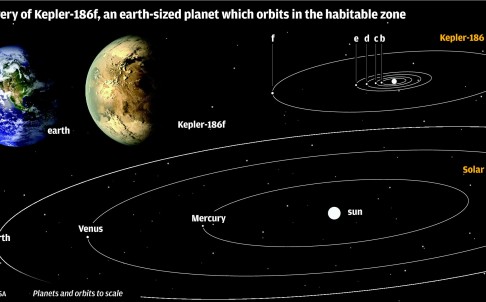Hunt for alien life homes in on Earth 2.0, a planet of similar size to our own
Researchers discover the first planet similar in size to our own and orbiting within so-called 'Goldilocks zone' of a star 500 light years away
PUBLISHED : Friday, 18 April, 2014, 8:58pm
UPDATED : Friday, 18 April, 2014, 8:58pm
Agence France-Presse in Washington

The hunt for potential life in outer space has taken a step forward - an international team of researchers has discovered the first earth-sized planet within the "habitable zone" of another star.
The exoplanet dubbed Kepler-186f was first spotted by scientists using Nasa's Kepler telescope, according to research published on Thursday in the US journal Science.
The exoplanet, located some 500 light years from earth, orbits in what is seen as the sweet spot around its star known as the "Goldilocks zone": not too close and not too far, so it could have liquid water, considered a crucial component to possibly hosting life. "The discovery of Kepler-186f is a significant step toward finding worlds like our planet earth," said Paul Hertz, who is Nasa's Astrophysics Division director at the agency's headquarters.
The planet was "the right size and is at the right distance to have properties that are similar to our home planet", said Elisa Quintana of the SETI Institute at Nasa's Ames Research Centre in California, the lead author of the paper published in Science.
"We can now say that other potentially habitable worlds, similar in size to earth, can exist. It's no longer in the realm of science fiction," she said, speaking at a press conference.
Kepler-186f is about 1.1-times the size of earth, which researchers say is key to predicting the composition of the surface and its atmosphere.
When planets are 1.5 times the size of earth or larger, many of them seem to attract a thick hydrogen and helium layer that makes them start to resemble gas giants such as Jupiter or Saturn.
Kepler-186f is the fifth and outermost planet orbiting the Kepler-186 star, right on the far edge of that solar system's habitable zone, meaning the surface temperature might not be warm enough to stop water from freezing. "However, it is also slightly larger than the earth, and so the hope would be that this would result in a thicker atmosphere that would provide extra insulation," explained San Francisco State University astronomer Stephen Kane, another member of the team behind the discovery.
Scientists using the Nasa's Kepler telescope first discovered it by tracking "transits" - shadows that cross in front of the star. But current technology does not allow astronomers to see the celestial body directly or do any analysis to determine its atmosphere or composition.
"Some people call these habitable planets, which of course we have no idea if they are," said Kane. "We simply know that they are in the habitable zone, and that is the best place to start looking for habitable planets."
Solar systems such as Kepler-186, with an M-Dwarf star at its centre, may be the best chance for finding a habitable planet, because there are so many of such stars and because many are very nearby.
However, because M-dwarfs are cooler, smaller and dimmer than our sun, they interact differently with planets, the researchers have said.
Kepler-186f was therefore "more like an earth cousin than an earth twin. It has similar characteristics but a different parent", Tom Barclay, researcher at the Bay Area Environmental Research Institute at Ames said at the Nasa press conference.
The Kepler space telescope, launched in March 2009, observes some 150,000 stars.
